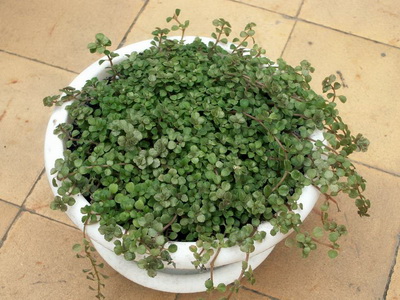The genus Pilea belongs to the Nettle family. Pileas are distributed throughout the subtropical and tropical regions, as well as in temperate zones. The genus name comes from the Latin pileus (“hat, cap”): one of the tepals in many species of pili has the shape of a hood.
Pilea species
Pilea Cadieri (Pilea cadieri) is a bushy herbaceous plant with erect stems up to 40 cm high. Oval, pointed at the top, the leaves reach a length of 8-10 cm and 5 cm in width. Three veins are well defined on the leaves. The color of the surface of the leaves along the veins is green, between them – silvery. From below, the leaves of this species are light green. The flowers are small, inconspicuous.

Pilea small-leaved (Pilea microphylla) is a herbaceous perennial undersized plant up to 10-15 cm high. Juicy densely leafy shoots are sprawling, branching profusely. Convex from above, rounded light green leaves are very small (0.2-0.5 cm long), not the same in size. Small flowers of Pilea small-leaved are collected in small shields in the axils of the leaves.

Pilea wrapped (Pilea involucrata) is a small bushy plant up to 30 cm high with erect stems. The leaves are opposite, oval in shape, pointed at the end, up to 7 cm long. The leaf surface is tuberous, light green, brown along the veins. This type of pilea is the source for many hybrid forms, including creeping.

Pilea peperomoides is a bushy plant up to 45 cm high. The leaves are almost round in shape, about 7 cm in diameter, located on long petioles.

Pilea Lebanese (Pilea libanensis) is an unpretentious ampelous plant. Forms long brownish shoots with opposite ovate leaves up to 1 cm long.

Pilea compressed (Pilea depressa) is very similar to its closest relative – indoor flower Pilea monetolista. The main difference between plants in the size of the leaves: the width of the leaves of the compressed pilea does not exceed 6 mm.

Pilea care at home
Pilea indoor plant prefers bright places or in partial shade, but not in direct sunlight. In summer, the flower is kept at room temperature, in winter the temperature is reduced to 16-18 ° C. On warm summer days, the plant is taken out into the air, protecting from the bright sun. In winter, he also needs a bright place – in poor lighting, the leaves lose their decorative effect. In cold weather, protection from drafts is necessary.
Water moderately in summer, after the top layer of soil dries up, in winter – limitedly. Pilea suffers more from excess moisture than from overdrying the soil. When caring for a pilea at home, it is necessary to ensure high humidity, but spraying can damage plants – pubescent leaves will lose their decorative effect. It is enough to put a container with water, wet sand or moss near the plant.
Pileas are fed with flower fertilizer from March to August weekly, in autumn and winter – once a month. Transplanted annually in spring or summer. The soil mixture is prepared from equal parts of soddy, humus soil, peat and sand (pH 5.5-6). Pots are taken shallow, since the root system of plants is superficial. Good drainage is required with a layer of 1.5-2 cm.
During the period of intensive growth, long shoots are pinched. With age, Pileas lose their leaves, so the plants renew every one to two years.
Propagated by shoots and green cuttings, rooted in a loose substrate – sand, peat or perlite. Cuttings are taken throughout the year, but the best results are obtained in spring and summer. In winter, it is necessary to additionally highlight the Pileas, observe the optimal watering and heat regimes. Rooted plants are planted in a mixture of leafy and soddy soil with sand (2:2:1).
Spider mites, scale insects, thrips harm the room saw.







